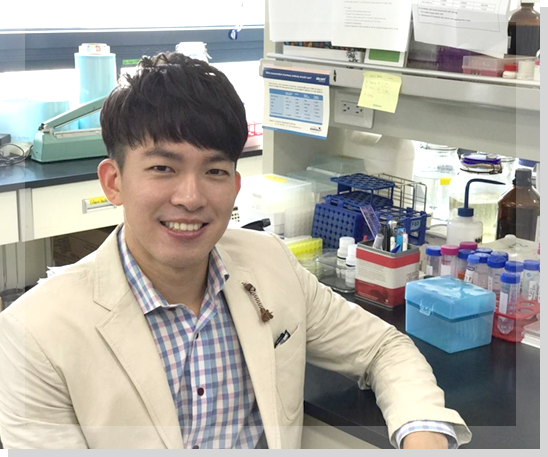Core Faculty Members

Assistant Professor Jung-Hwan Lee Core Faculty
Institute of Tissue Regeneration Enginnering (ITREN)
Jung-Hwan Lee received his Ph.D from Yonsei University in dental biomaterials and bioengineering (2015).
Before his doctorate degree, he obtained DDS as a dentist from Dankook University.
Before joining Dankook University, he worked as research fellow in ITREN supervised by Dr. Hae-Won Kim.
His research is aimed at analyzing the physical, chemical and biological properties of dental biomaterials including nanoparticles or their complex, as well as exploring its clinical applicability.
He is particularly interested in cell reprogramming and mechanotransduction by an ECM-Cell-Nucleus channel.
Degree
- Bachelor degree: From Dankook University, DDS (Dentisty) (2005.3-2011.2)
- Ph.D: From Yonsei University, PhD (Biomaterial science) (2011.3-2015.2)
Career
- (2015-2018) – Postdoctoral Fellow, Institute of Tissue Regeneration Engineering (ITREN)
- (2018-current) – Professor, ITREN and Dental school in Dankook University
Other
- Board member of Korean society of dental materials
Selected Papers
- [22] Materials roles for promoting angiogenesis in tissue regeneration. Prog Mater Sci.(2020)
- [21] Nanotherapeutics for regeneration of degenerated tissue infected by bacteria through the multiple delivery of bioactive ions and growth factor with antibacterial/angiogenic and osteogenic/odontogenic capacity. Bioactive Mater (2020)
- [20] Revascularization and limb salvage following critical limb ischemia by nanoceria-induced Ref-1/APE1-dependent angiogenesis. Biomaterials (2020)
- [19] Development of Bis-GMA-free biopolymer to avoidestrogenicity. Dental Mater (2019)
- [18] Role of nuclear mechanosensitivity in determining cellular responses to forces and biomaterials. Biomaterials (2019)
- [17] Dual-ion delivery for synergistic angiogenesis and bactericidal capacity with silica-based microsphere. Acta Biomater (2019)
- [16] Ceria-incorporated MTA for acceleratingodontoblastic differentiation via ROS downregulation. Dental Mater (2019)
- [15] Multi-functional nano-adhesive releasing therapeutic ions for MMP-deactivation and remineralization. Scientific Reports (2018)
- [14] Nanocements produced from mesoporous bioactive glass nanoparticles. Biomaterials (2018)
- [13] Silk fibroin / collagen protein hybrid cell-encapsulating hydrogels with tunable gelation and improved physical and biological properties. Acta Biomater (2018)
- [12] Zirconia-incorporated zinc oxide eugenol has improved mechanical properties and cytocompatibility with human dental pulp stem cells. Dental Mater (2017)
- [11] Rechar geable microbial anti-adhesive polymethyl methacrylate incorporating silver sulfadiazine-loaded mesoporous silica nanocarriers. Dental Mater (2017)
- [10] Drug/ion co-delivery multi-functional nanocarrier to regenerate infected tissue defect. Biomaterials (2017)
- [9] Intracellular co-delivery of Sr ion and phenamil drug through mesoporous bioglass nanocarriers synergizes BMP signaling and tissue mineralization. Acta Biomater (2017)
- [8] Sol-gel-derived bioactive glass nanoparticle-incorporated glass ionomer cement with or without chitosan for enhanced mechanical and biomineralization properties. Dental Mater (2017)
- [7] Non-thermal atmospheric pressure plasma functionalized dental implant for enhancement of bacterial resistance and osseointegration. Dental Mater (2017)
- [6] Immunomodulatory/anti-inflammatory effect of ZOE-based dental materials. Dental Mater (2017)
- [5] Xerogel interfaced nanofibers stimulate bone regeneration through the activation of integrin and bone morphogenetic protein pathways. J Biomed Nanotech (2017)
- [4] Development of long-term antimicrobial poly(methyl methacrylate) by incorporating mesoporous silica nanocarriers. Dental Mater (2016)
- [3] Magnetic nanofiber scaffold-induced stimulation of odontogenesis and pro-angiogenesis of human dental pulp cells through Wnt/MAPK/NF-κB pathways. Dental Mater (2016)
- [2] Effect of aminated mesoporous bioactive glass nanoparticles on the differentiation of dental pulp stem cells. PLoS One (2016)
- [1] Magnetic nanocomposite scaffold-induced stimulation of migration and odontogenesis of human dental pulp stem cells through integrin signaling pathways. PLoS One (2015)





